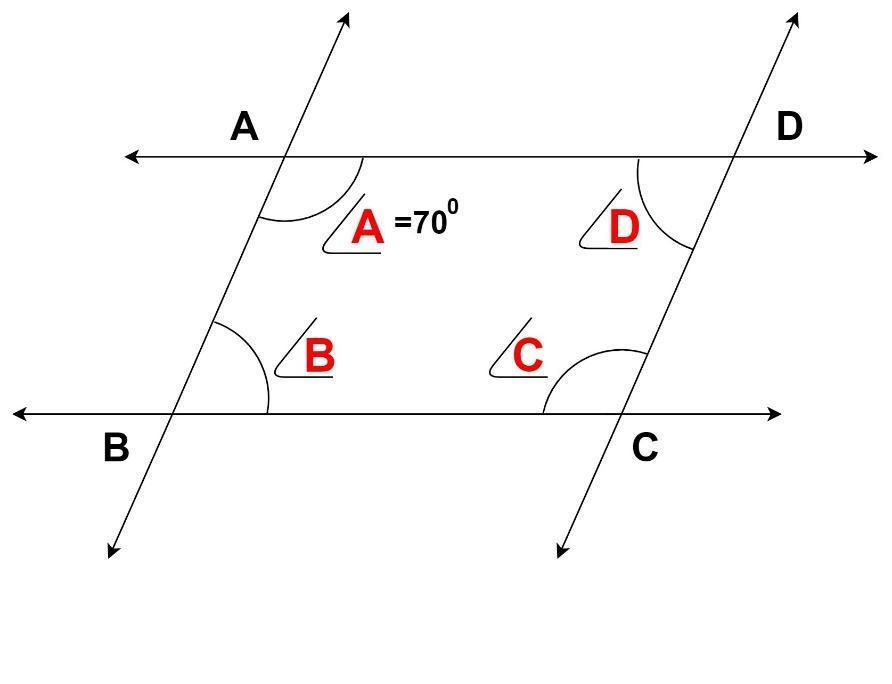
Answer
501.6k+ views
Hint: Use geometrical theorems related to parallel lines.
Given in the problem ABCD is a parallelogram with angle $\angle A = {70^0}$.
We know that opposite sides of the parallelogram are parallel to each other.
$
\Rightarrow AB{\text{ is parallel to }}CD{\text{ (1)}} \\
\Rightarrow AD{\text{ is parallel to B}}C{\text{ (2)}} \\
$
Same side Interior angle theorem states that the interior angles formed by a transversal line intersecting two parallel lines are supplementary.
Using the same theorem in parallelogram $ABCD$, we get:
\[
(1) \Rightarrow {\text{ }}\angle A + \angle D = {180^0}{\text{ and }}\angle B + \angle C = {180^0} \\
(2) \Rightarrow {\text{ }}\angle A + \angle B = {180^0}{\text{ and }}\angle C + \angle D = {180^0} \\
\]
Using angle $\angle A = {70^0}$ in above equations, we get:
\[
{70^0} + \angle D = {180^0}{\text{ }} \\
\Rightarrow \angle D = {110^0} \\
{70^0} + \angle B = {180^0} \\
\Rightarrow \angle B = {110^0} \\
\angle B + \angle C = {180^0} \\
\Rightarrow \angle C = {70^0} \\
\]
Hence\[{\text{ }}\angle B = {110^0}{\text{ , }}\angle C = {70^0}{\text{ , }}\angle D = {110^0}\] .
Note: The same side interior angle theorem is only valid for parallel lines. Geometric properties of parallelogram and parallel lines should be kept in mind while solving problems like this.
Given in the problem ABCD is a parallelogram with angle $\angle A = {70^0}$.
We know that opposite sides of the parallelogram are parallel to each other.
$
\Rightarrow AB{\text{ is parallel to }}CD{\text{ (1)}} \\
\Rightarrow AD{\text{ is parallel to B}}C{\text{ (2)}} \\
$
Same side Interior angle theorem states that the interior angles formed by a transversal line intersecting two parallel lines are supplementary.
Using the same theorem in parallelogram $ABCD$, we get:
\[
(1) \Rightarrow {\text{ }}\angle A + \angle D = {180^0}{\text{ and }}\angle B + \angle C = {180^0} \\
(2) \Rightarrow {\text{ }}\angle A + \angle B = {180^0}{\text{ and }}\angle C + \angle D = {180^0} \\
\]
Using angle $\angle A = {70^0}$ in above equations, we get:
\[
{70^0} + \angle D = {180^0}{\text{ }} \\
\Rightarrow \angle D = {110^0} \\
{70^0} + \angle B = {180^0} \\
\Rightarrow \angle B = {110^0} \\
\angle B + \angle C = {180^0} \\
\Rightarrow \angle C = {70^0} \\
\]
Hence\[{\text{ }}\angle B = {110^0}{\text{ , }}\angle C = {70^0}{\text{ , }}\angle D = {110^0}\] .
Note: The same side interior angle theorem is only valid for parallel lines. Geometric properties of parallelogram and parallel lines should be kept in mind while solving problems like this.
Recently Updated Pages
Fill in the blanks with suitable prepositions Break class 10 english CBSE

Fill in the blanks with suitable articles Tribune is class 10 english CBSE

Rearrange the following words and phrases to form a class 10 english CBSE

Select the opposite of the given word Permit aGive class 10 english CBSE

Fill in the blank with the most appropriate option class 10 english CBSE

Some places have oneline notices Which option is a class 10 english CBSE

Trending doubts
Fill the blanks with the suitable prepositions 1 The class 9 english CBSE

How do you graph the function fx 4x class 9 maths CBSE

Which are the Top 10 Largest Countries of the World?

What is the definite integral of zero a constant b class 12 maths CBSE

The Equation xxx + 2 is Satisfied when x is Equal to Class 10 Maths

Differentiate between homogeneous and heterogeneous class 12 chemistry CBSE

Define the term system surroundings open system closed class 11 chemistry CBSE

Full Form of IASDMIPSIFSIRSPOLICE class 7 social science CBSE

Change the following sentences into negative and interrogative class 10 english CBSE





